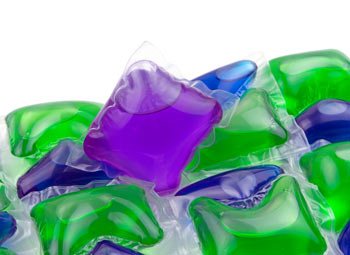A Hidden Laundry Room Danger for Dogs: Laundry Pods

Did you know that laundry detergent is toxic to dogs? It's true, but it wasn't too much of an issue in the past because most detergents were inside a bottle. If a dog did ingest some, it was usually just a tiny amount licked off the floor. Some drooling and mild vomiting and diarrhea were often seen as a result, but the amount ingested was not usually enough to cause a serious problem.
However, with the advent of detergent pods, a bigger threat is present and more detergent injuries to dogs are being seen.
Why Are Detergent Pods So Dangerous to Dogs?
Laundry or detergent pods are colorful packets containing a pre-set amount of laundry detergent. They can be quite convenient for people, who can just grab a pod and toss it into the machine. This reduces the time and mess associated with pouring detergent out of a container.
The problem for dogs is the result of five facts about laundry pods:
- Detergent pods look like dog toys and are the perfect size for a dog to grab with his mouth.
- It's easier for a pod to end up on the floor or elsewhere where a dog can reach it than it is for enough laundry detergent from a container to end up in a similar spot.
- The contents of detergent pods are under pressure, so if a dog's tooth penetrates one, the contents shoot out. The detergent may then be inhaled or swallowed by the dog.
- The laundry detergent in pods is highly concentrated, so a dog doesn't need to ingest as much of it as he would bottled detergent to experience serious problems.
- Because the pods are designed to dissolve in the washing machine, they can weaken and burst even without being bitten by the dog, as saliva breaks them down.
Inhaling the detergent is far more dangerous for a dog than swallowing it. Once inhaled, the detergent coats the lungs and causes the dog to be unable to exchange oxygen properly, possibly resulting in suffocation. There are two ways that inhalation may occur when a dog plays with the laundry pod:
- When the pod breaks and shoots out detergent, the dog may inhale it immediately.
- If the dog ingests the detergent, the resulting irritation to the stomach often causes vomiting. Because the detergent becomes foamy in the stomach, it can easily be inhaled into the lungs as it is vomited up.
If a dog ingests multiple detergent pods, the additional risks of intestinal obstruction and corrosion of the G.I. tract by the large amount of concentrated detergent are possible.
Signs of Laundry Pod Poisoning in Dogs
If your dog has ingested or inhaled the contents of a detergent pod, you may see some or all of the following signs of illness:
- Vomiting
- Diarrhea
- Coughing
- Foaming at the mouth (and you may be able to smell the detergent on the dog's breath)
- Lethargy
- Labored breathing
- Rubbing at the eyes, nose, or mouth
Treatment of Canine Detergent Pod Toxicity
Treatment of detergent poisoning in dogs includes diluting as much of the detergent as possible. It's important to rinse out your dog's mouth as well as possible and wash off any detergent on his face or fur.
Contact your veterinarian or the Pet Poison Hotline at 855-764-7661 immediately for further instructions.
If your dog is having difficulty breathing, get him to your veterinarian or an emergency veterinary clinic as quickly as possible. The veterinarian may need to administer oxygen treatment, intravenous fluids, and other supportive measures.
Prevention of Laundry Pod Poisoning in Dogs
It's crucial to keep all laundry products out of the reach of your dog. In fact, you may wish to limit your dog's access to your laundry room.
Laundry pods are an extreme hazard to children and cats as well as dogs.
You May Also Like These Articles/Recipes:
Retractable Dog Leashes: Know the Risks
A New Dog Bowel Obstruction Risk You Need to Know About
10 Ways You Could Be Shortening Your Dog's Life - Slideshow
Sago Palms Are Extremely Toxic to Dogs
Emergency Care for Suspected Poisoning
How to Avoid Expensive Veterinary Bills for Your Dog
Disclaimer: This website is not intended to replace professional consultation, diagnosis, or treatment by a licensed veterinarian. If you require any veterinary related advice, contact your veterinarian promptly. Information at DogHealth.com is exclusively of a general reference nature. Do not disregard veterinary advice or delay treatment as a result of accessing information at this site. Just Answer is an external service not affiliated with DogHealth.com.
Notice: Ask-a-Vet is an affiliated service for those who wish to speak with a veterinary professional about their pet's specific condition. Initially, a bot will ask questions to determine the general nature of your concern. Then, you will be transferred to a human. There is a charge for the service if you choose to connect to a veterinarian. Ask-a-Vet is not manned by the staff or owners of DogHealth.com, and the advice given should not delay or replace a visit to your veterinarian.



